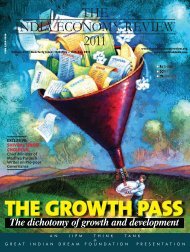Download - The India Economy Review
Download - The India Economy Review
Download - The India Economy Review
Create successful ePaper yourself
Turn your PDF publications into a flip-book with our unique Google optimized e-Paper software.
P LANNING P ARADIGM<br />
livelihoods are intricately linked with the<br />
access of rural people to natural resources<br />
such as, land, water and biotic resources.<br />
A livelihood is sustainable when it can<br />
cope with and recover from stresses and<br />
shocks and maintain or enhance its capabilities<br />
and assets both now and in the<br />
future, while not undermining the natural<br />
resource base (Carney, 1998: 4).<br />
Livelihood Assets<br />
About how to improve the effectiveness<br />
of government poverty reduction schemes,<br />
the sustainable (SL) approach provides a<br />
coherent framework within which multisectoral<br />
activities can be placed, and ties<br />
in closely with the new guidelines of the<br />
ministry of Rural Development, Government<br />
of <strong>India</strong> (GOI, 1994). It provides<br />
new ways to address poverty issues beyond<br />
the traditional method of employment<br />
generation and target group programmes.<br />
As the basis for sustainable improvement<br />
of people’ livelihoods, it emphasizes livelihood<br />
assets in terms to fi ve capital assets<br />
–natural, physical, fi nancial, human and<br />
social — identifi ed in the framework (Carney,<br />
1998; Davis, 1996; Reddy et al., 2004).<br />
Participatory initiative in natural resource<br />
management programmes such as water<br />
development, water lands development,<br />
joint forest management, coastal zone<br />
development, typify this approach.<br />
<strong>The</strong>se fi ve capital assets are conventionally<br />
associated with a stock, whereas there<br />
are many aspects of the fi ve assets that are<br />
akin to fl ows in the dynamics of livelihood<br />
operations. A better understanding of<br />
these concepts can be gained by looking<br />
at them in relation to entitlement theory<br />
(Sen, 1982, 1985; Scoones, 1998). <strong>The</strong><br />
livelihood assets, in this perspective, can<br />
be seen as a capability or a potential that<br />
can be deployed to undertake, or be in-<br />
140 THE IIPM THINK TANK<br />
vested in livelihood activities. But they are<br />
not uniform in character: for example,<br />
under natural capital, access to food fodder,<br />
fuel wood are dependent on the fl ow<br />
of these resources through the cycle of<br />
community forest management, whereas<br />
social capital can take the form of the<br />
network of social relationships among<br />
individuals, families, communities and<br />
states that have potential to infl uence the<br />
viability of livelihood activities. From this<br />
perspective, livelihood capital will accumulate<br />
where the potential to which the<br />
household, the community and the state<br />
have an entitlement increases.<br />
But, with regard to the growth of fi nancial<br />
capital, fi nancial capital is ultimately<br />
employed in accumulation of physical<br />
capital, human capital, technology and the<br />
investment in natural resources (measured<br />
in terms of changes in access to or improvements<br />
in land, water, and other common<br />
pool resources). Similarly, as social capital<br />
is an attribute of an individual in a social<br />
context (Sobel, 2002:139), the growth of<br />
social capital depends on the ‘institutions,<br />
relationships, attitudes and values that<br />
govern interactions among people and<br />
contribute to economic and social development’<br />
(WORLD BANK, 2002: 2). <strong>The</strong>se<br />
attributes come into being by the nature<br />
of participation, type of participation and<br />
the process of participation of the local<br />
communities in the management of natural<br />
resources and common activities. Kenneth<br />
Arrow (1999) argues that social<br />
capital shares the temporal aspect of<br />
physical capital but does not require ma-<br />
terial sacrifi ce (cited in Sobel, 2002: 144).<br />
Communities that have high network of<br />
social relationships have high growth of<br />
social capital and they are more successful<br />
in managing irrigation projects, water supply<br />
and sanitation projects and many<br />
other infrastructural projects including<br />
common pool resources (CPRs) and common<br />
activities. It is argued that while the<br />
poor have little access to other capital assets,<br />
they often do have substantial social<br />
capital, such as social networks and connections<br />
through membership of organization,<br />
clientelism, and so on, which allow<br />
them to weather subsistence crises and<br />
might even afford them the possibility of<br />
capital accumulation and a way out of<br />
poverty (Ray, 2006: 462).<br />
Admittedly, as an engine of economic<br />
growth, natural capital is also an important<br />
source of growth of <strong>India</strong>n economy<br />
as other capital assets. Most importantly,<br />
<strong>The</strong> livelihood assets can be seen as<br />
a capability that can be deployed to<br />
undertake livelihood activities<br />
as the growth of fi nancial and social capi-<br />
tal assets, the growth of natural capital<br />
does not ultimately depend on the source<br />
of growth of other capital assets. As natu-<br />
ral capital is a major source of capital and<br />
a major source of livelihood of the major-<br />
ity of the people of <strong>India</strong>n economy, it is<br />
also an important source of growth of<br />
<strong>India</strong>n economy as physical capital , hu-<br />
man capital and technology . But the draft<br />
approach paper of Eleventh Five Year<br />
Plan of <strong>India</strong> (2007- 12) fails to include<br />
natural capital into it as a source of<br />
growth. So, without any piecemeal devel-<br />
opment programme, sustainable develop-<br />
ment programmes that integrates natural





